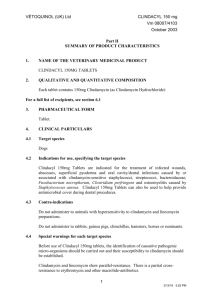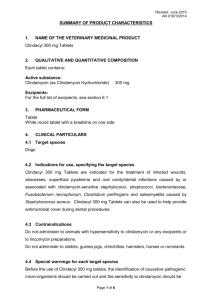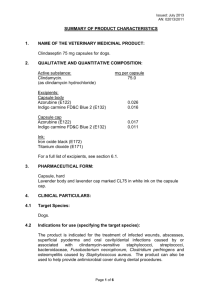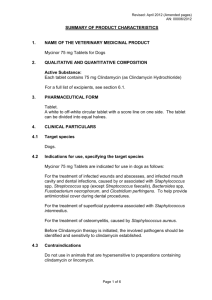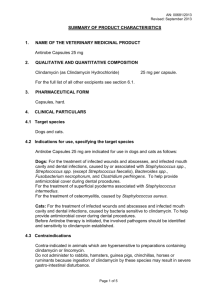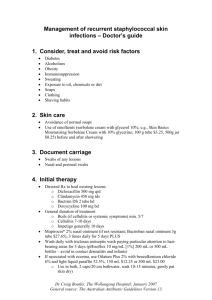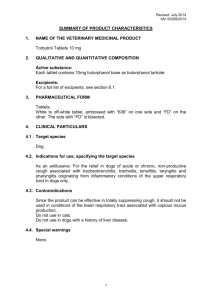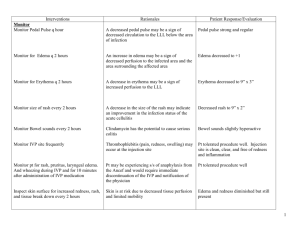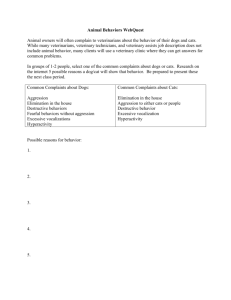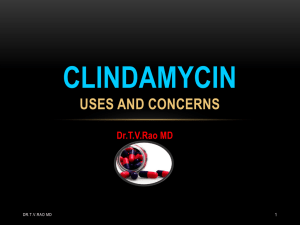Revised: May 2014 AN. 00090/2014 SUMMARY OF THE PRODUCT
advertisement
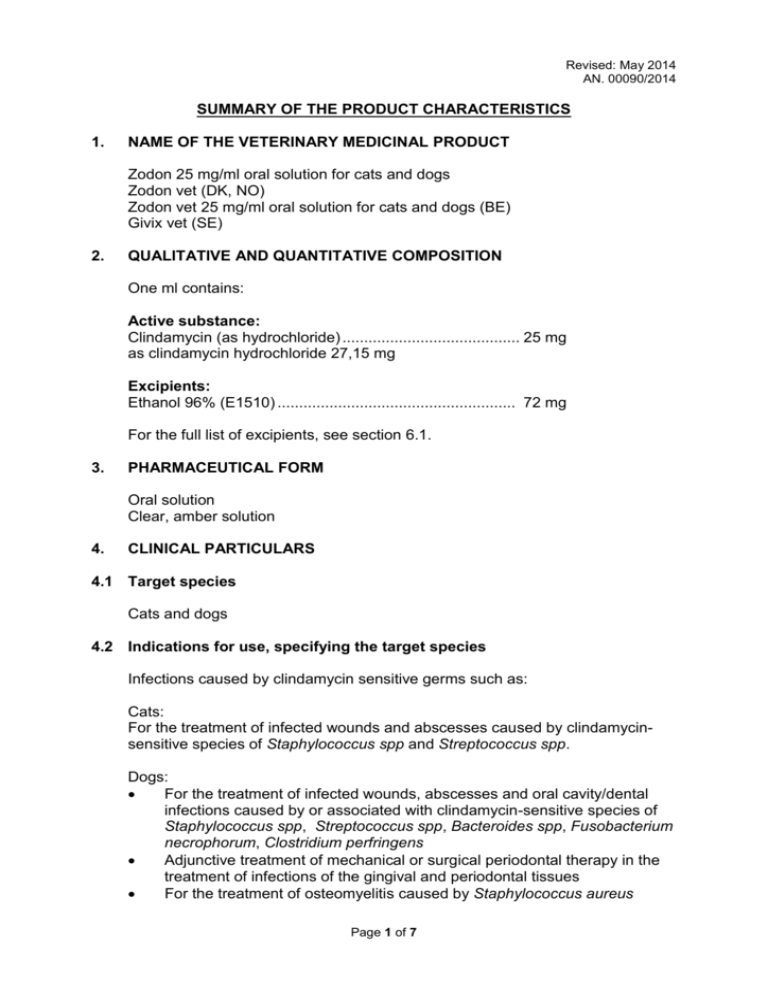
Revised: May 2014 AN. 00090/2014 SUMMARY OF THE PRODUCT CHARACTERISTICS 1. NAME OF THE VETERINARY MEDICINAL PRODUCT Zodon 25 mg/ml oral solution for cats and dogs Zodon vet (DK, NO) Zodon vet 25 mg/ml oral solution for cats and dogs (BE) Givix vet (SE) 2. QUALITATIVE AND QUANTITATIVE COMPOSITION One ml contains: Active substance: Clindamycin (as hydrochloride) ......................................... 25 mg as clindamycin hydrochloride 27,15 mg Excipients: Ethanol 96% (E1510) ....................................................... 72 mg For the full list of excipients, see section 6.1. 3. PHARMACEUTICAL FORM Oral solution Clear, amber solution 4. CLINICAL PARTICULARS 4.1 Target species Cats and dogs 4.2 Indications for use, specifying the target species Infections caused by clindamycin sensitive germs such as: Cats: For the treatment of infected wounds and abscesses caused by clindamycinsensitive species of Staphylococcus spp and Streptococcus spp. Dogs: For the treatment of infected wounds, abscesses and oral cavity/dental infections caused by or associated with clindamycin-sensitive species of Staphylococcus spp, Streptococcus spp, Bacteroides spp, Fusobacterium necrophorum, Clostridium perfringens Adjunctive treatment of mechanical or surgical periodontal therapy in the treatment of infections of the gingival and periodontal tissues For the treatment of osteomyelitis caused by Staphylococcus aureus Page 1 of 7 Revised: May 2014 AN. 00090/2014 4.3 Contraindications Clindamycin should not be administered to hamsters, guinea pigs, rabbits, chinchillas, horses or ruminants because clindamycin ingestion in those species could cause severe digestive disorders. Do not use in cases of hypersensitivity to either clindamycin or lincomycin, or to any of the excipients 4.4 Special warnings for each target species None. 4.5 Special precautions for use i) Special precautions for use in animals Inappropriate use of the product may increase the prevalence of bacteria resistant to clindamycin. Whenever possible, clindamycin should only be used based on susceptibility testing including the D-zone test. Official national and local antimicrobial policies should be taken into account when the product is used Clindamycin shows parallel-resistance with lincomycin and co-resistance with erythromycin. There is a partial cross-resistance to erythromycin and other macrolides. In case of administration of high doses of clindamycin or during prolonged therapy of one month or greater, tests for liver and renal functions and blood counts should be performed periodically In dogs and cats with kidney problems and/or liver problems, accompanied by severe metabolic aberrations, the dose to be administered should be carefully determined and their condition should be monitored by performing appropriate blood tests during treatment. The use of the product is not recommended in neonates. ii) Special precautions to be taken by the person administering the veterinary medicinal product to animals Wash hands carefully after use. People with known hypersensitivity to lincosamides (lincomycin and clindamycin) should avoid contact with the veterinary medicinal product. In case of accidental ingestion, seek medical advice immediately and show the package leaflet or the label to the physician 4.6 Adverse reactions (frequency and seriousness) Vomiting and/or diarrhoea have been observed Clindamycin is likely to favour the proliferation of non-susceptible organisms such as resistant Clostridia spp and yeasts. In case of secondary infection, appropriate corrective measures should be taken based on clinical observations. Page 2 of 7 Revised: May 2014 AN. 00090/2014 4.7 Use during pregnancy, lactation or lay While high dose studies in rats suggests that clindamycin is not a teratogen and does not significantly affect the breeding performance of males and females, the safety of the veterinary medicinal product in pregnant bitches/queens or breeding male dogs/cats has not been established. Use only according to the benefit/risk assessment by the responsible veterinarian. Clindamycin can pass the placenta and blood-milk barrier. As a consequence, treatment of lactating females can cause diarrhoea in puppies and kittens. 4.8 Interaction with other medicinal products and other forms of interaction - - Aluminium salts and hydroxides, kaolin and Aluminium-Magnesium-Silicat complex may reduce lincosamides digestive absorption. These digestive topics should be administered at least 2 hours before clindamycin. Cyclosporin: clindamycin may reduce levels of this immunosuppressive drug with a risk of lack of activity. - Neuro-muscular blocking agents: Clindamycin possesses intrinsic neuromuscular blocking activity and should be used cautiously with other neuromuscular blocking agents (curares). Clindamycin may increase neuromuscular blockade. - Do not use clindamycin simultaneously with chloramphenicol or macrolides as they both target the ribosome 50S subunit and antagonist effects may develop. When using simultaneously clindamycin and aminoglycosides (i.e gentamicin), the risk of adverse interactions (acute renal failure) cannot be excluded. - Page 3 of 7 Revised: May 2014 AN. 00090/2014 4.9 Amounts to be administered and administration route For oral administration only Recommended dose: Cats: infected wounds, abscesses : 11mg of clindamycin per kg of body weight per 24h or 5.5 mg /kg per 12h for 7 to 10 days The treatment should be stopped if no therapeutic effect is observed after 4 days. Dogs: - Infected wounds, abscesses and oral cavity/dental infections: 11 mg clindamycin per kg of body weight per 24h or 5.5 mg /kg per 12h for 7 to 10 days. The treatment should be stopped if no therapeutic effect is observed after 4 days. - Treatment of bone infections (osteomyelitis): 11 mg clindamycin per kg of body weight every 12 hours during a period of 28 days minimum. The treatment should be discontinued if no therapeutic effect is observed in the first 14 days. - Dosage - - 5.5 mg/kg - - 11 mg/kg - Volume to be administered per kg bodyweight Corresponding approximately to 0.25 ml per kg Corresponding approximately to 0.5 ml per kg To ensure administration of a correct dose, body weight should be determined as accurately as possible. A 3 ml graduated syringe is provided to facilitate the administration of the veterinary medicinal product. The solution is flavoured. The solution can be administered directly into the mouth of the animal or added to a small quantity of food. 4.10 Overdose (symptoms, emergency procedures, antidotes), if necessary High dose levels up to 300 mg/kg have been well tolerated in dogs without any adverse effects. Vomiting, loss of appetite, diarrhoea, leukocytosis and elevated liver enzymes have been observed occasionally. In such cases, discontinue the treatment and administer a symptomatic treatment. Page 4 of 7 Revised: May 2014 AN. 00090/2014 4.11 Withdrawal period Not applicable. 5. PHARMACOLOGICAL PROPERTIES Pharmacotherapeutic group: Anti-infectives for systemic use, lincosamides ATCvet code: QJ01FF01 5.1 Pharmacodynamic properties Clindamycin is mainly a bacteriostatic antibiotic belonging to the group of lincosamides. Clindamycin is a chlorinated analogue of lincomycin. It works by inhibiting bacterial protein synthesis. The reversible coupling to the sub-unit 50S bacterial ribosome inhibits translation of amino acids linked to the tRNA, thereby preventing elongation of the peptide chain. That is why the mode of action of clindamycin is predominantly bacteriostatic. Clindamycin and lincomycin have cross-resistance, which is also common between erythromycin and other macrolides. Acquired resistance can occur, by methylation of the ribosomal binding site via chromosomal mutation in gram positive organisms, or by plasmid-mediated mechanisms in gram negative organisms Clindamycin is active in vitro against many Gram-positive bacteria, Gram positive and Gram-negative anaerobic bacteria. Most aerobic Gram-negative bacteria are resistant to clindamycin. “CLSI clindamycin veterinary breakpoints are available for dogs in Staphylococcus spp. and Streptococci-ß-haemolytic group in skin and soft tissue infections: S ≤0.5μg/ml; I=1-2μg/ml; R ≥ 4μg/ml”. (CLSI July 2013). The incidence of resistance to lincosamides in Staphylococcus spp. appears to be wide-ranging in Europe. Recent studies (2010) report an incidence between 25 to 40%.. 5.2 Pharmacokinetic particulars Clindamycin is almost completely absorbed after oral administration. After oral administration of 11mg/kg, maximum plasma concentrations of 8µg/ml are reached within one hour (without any influence of food ). Clindamycin is widely distributed and may concentrate in some tissues. Elimination half life of clindamycin is around 4 hours. Approximately 70% is excreted in faeces and 30% in the urine. Clindamycin is approximately 93% bound to plasma proteins. Page 5 of 7 Revised: May 2014 AN. 00090/2014 6. PHARMACEUTICAL PARTICULARS 6.1 List of excipients Glycerol (E422) Sorbitol liquid (non crystallising) Sucrose (saccharose) Ethanol 96° Propylene glycol (E1520) “Grilled note” flavour Monohydrate citric acid (E330) Purified water 6.2 Incompatibilities Do not mix this product with any other veterinary medicinal products. 6.3 Shelf life Shelf life of the veterinary medicinal product as packaged for sale: 21 months Shelf life after first opening the immediate packaging: 28 days 6.4. Special precautions for storage Do not store above 30oC 6.5 Nature and composition of immediate packaging A cardboard box containing: - a 20 mL amber translucent multidose bottle made in glass material (type III), - a childproof white cap equipped with an inviolability ring, made in high density polyethylene; fitted with a transparent low density polyethylene part inside (insert) - a 3 mL syringe for oral use equipped with a tip cannula (transparent natural barrel made of polypropylene and white plunger made of high density polyethylene material) 6.6 Special precautions for the disposal of unused veterinary medicinal product or waste materials derived from the use of such products Any unused veterinary medicinal product or waste materials derived from such veterinary medicinal product should be disposed of in accordance with local requirements. Page 6 of 7 Revised: May 2014 AN. 00090/2014 7. MARKETING AUTHORISATION HOLDER Sogeval 200 Avenue de Mayenne Zone Industrielle des Touches 53000 Laval France 8. MARKETING AUTHORISATION NUMBER Vm: 20749/4036 9. DATE OF FIRST AUTHORISATION Date: 16 April 2014 10. DATE OF REVISION OF THE TEXT Date: May 2014 PROHIBITION OF SALE, SUPPLY AND/OR USE To be completed in accordance with national requirements 03 June 2014 Page 7 of 7
